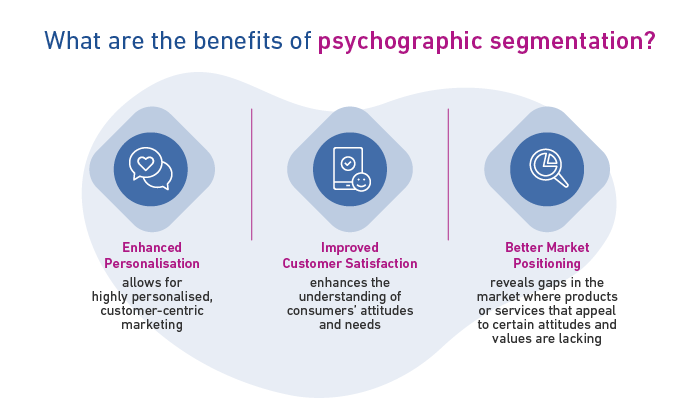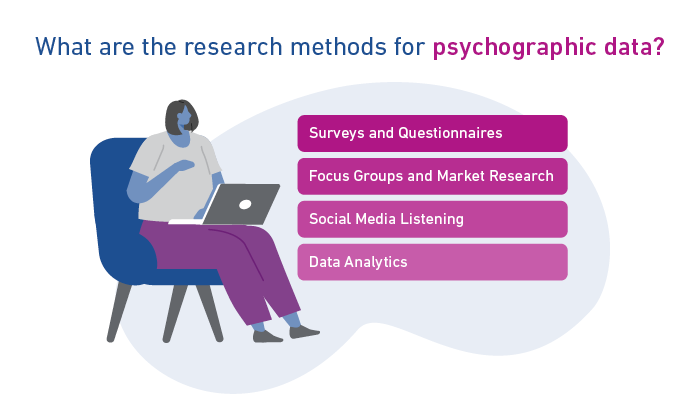What is psychographic segmentation?
Psychographic segmentation (or attitudinal segmentation) groups consumers based on their shared attitudes towards a brand – what they think, feel, believe and value in a brand or product. It’s a way of understanding why your target audience do what they do.
Transform your marketing strategy
In the ever-shifting world of marketing, the way that we understand the consumer has to constantly evolve too. Delving for detail beyond the basics is becoming increasingly necessary, and it’s where market segmentation using psychographic data comes into play.
Psychographic data (sometimes known as attitudinal data) is information about people’s thoughts, feelings, and opinions toward a brand, product or service. It uncovers the emotional and psychological drivers behind consumer decisions, helping companies to understand and measure the effects that they have on their customers.
Here, we’ll explore what psychographic segmentation is, why it’s a key part of audience segmentation, and how it can transform your marketing strategy.
What is psychographic segmentation?
Psychographic segmentation (or attitudinal segmentation) groups consumers based on their shared attitudes towards a brand – what they think, feel, believe and value in a brand or product. It’s a way of understanding why your target audience do what they do. It’s possible that two consumers may be very similar in terms of their behaviours, demographics and geographics, yet their attitudes and motivations may be very different.
This approach allows businesses to align their marketing strategies with the core sentiments of their consumer base and to connect with them more meaningfully.
Psychographic segmentation is one of the key types of segmentation. Others include geographic segmentation, behavioural segmentation and demographic segmentation. A further type which is very similar to psychographic segmentation is needs-based segmentation. A needs-based approach focuses on the principle that consumers with similar needs are more likely to have similar purchasing behaviours.
Types of psychographic segmentation
Some of the most common types of psychographic segmentation include:
1. Benefit-based Segmentation
A strategy which groups consumers based on the specific benefits they’re looking to get from a product or service, such as quality or cost-effectiveness.
2. Lifestyle Segmentation
A type of categorising which helps you define your audience’s interests and hobbies. It shows businesses why their consumers make the choices they do in terms of non-essential spending.
3. Value-based Segmentation
Segmenting the target market based on values and principles. It’s a perfect approach for brands that want to connect with consumers who share common social or ethical stances.
4. Opinion-based Segmentation
An approach which delves into consumer opinions on various issues. It can help a brand in crafting marketing campaigns for social or political causes.
What are the benefits of psychographic segmentation?
Psychographic segmentation recognises that attitudes are a huge part of what drives and influences purchasing behaviour. The insight that this type of customer segmentation affords you brings benefits such as:
- Enhanced Personalisation
Psychographic segmentation allows for highly personalised, customer-centric marketing. By aligning your messages with your customers’ beliefs and values you create deeper connections with them, resulting in higher engagement and stronger brand loyalty.
- Improved Customer Satisfaction
Enhanced understanding of your consumers’ attitudes, and therefore ability to meet their needs, results in higher customer satisfaction as your audience feels valued and understood.
- Better Market Positioning
Segmenting based on attitudes reveals gaps in the market where products or services that appeal to certain attitudes and values are lacking. Businesses can use this knowledge to refine their buyer personas and subsequently position what they offer to meet these previously unmet needs.

Psychographic vs behavioural research: what’s the difference?
Before we journey any deeper, let’s clarify the difference between psychographic and behavioural segmentation:
- Psychographic research dives into what the consumer thinks, feels, and believes. It helps businesses understand what their target audience wants to see from a brand, product or service.
- Behavioural research observes what consumers actually do. It tracks their actions, how they spend, and when they spend.
Psychographic research provides the key to understanding consumer motivations and intentions, whereas behavioural research provides concrete data on consumer interaction with a product or service.
In practice, if you’re looking to revise your mission statement to better appeal to your consumers, psychographic data can help you understand what values they want from a brand. For example, Tesla’s mission statement, “To accelerate the world’s transition to sustainable energy,” directly aligns with those likely to purchase their product: electric vehicles.
However, if you’re trying to map your customer journeys or understand purchase tendencies, behavioural data is key. These are just a few of the countless ways you can use data segmentation to improve your sales and marketing campaigns.
Examples of psychographic segmentation
Imagine you sell a range of bamboo sleepwear. Using psychographic segmentation, you identify a cluster of consumers who prioritise natural and sustainable products when shopping for pyjamas. Through understanding this attitude, you then create a high-quality marketing message that emphasises these qualities and resonates strongly with this group, increasing sales.
A real-world example of a successful psychographic segmentation strategy that has won over environmentally conscious consumers is Patagonia’s. An outdoor brand, their brand message harmonises with the values of their customers – deep commitment to sustainability and the environment – helping them to succeed massively in their goals.
What are the research methods for psychographic data?
This type of research measures attitudes and opinions and is therefore collected through self-reported methods. The research is most often qualitative – using open-ended questions to better understand why people feel the way that they do.
Open-ended questions encourage the respondent to answer from the entirety of their knowledge. It is not limited by pre-determined answer options. The detail afforded by an open-ended question provides deep and valuable insight into the consumer and their habits regarding the subject. The most common research methods include:
- Surveys and Questionnaires
An in-depth survey or questionnaire allows brands to ask consumers directly about their beliefs, values and preferences.
- Focus Groups and Market Research
Bringing small groups of individuals together to discuss their opinions.
- Social Media Listening
Analysing social media conversations, comments, and posts to discover consumer traits.
- Data Analytics
Using advanced analytical data, like machine learning, to review large datasets and reveal less obvious patterns of consumer behaviour.

Psychographic research can also, though less often, be quantitative: using closed-ended questions to find out how often people have specific attitudes and opinions. This involves asking participants to choose answers from a set of options – e.g. multiple choice or ‘yes/no’. Allocating a value to each answer means you can easily quantify the responses of individuals which, in turn, enables statistical analysis of the findings.
How to use psychographic data
Being able to target segments of the market based on their thoughts and feelings can be extremely advantageous for a business. Marketers can use this understanding of people’s motivations to inform a more effective communication strategy, helping to deliver products or experiences that properly address the customer’s needs.
A brand can also use psychographic data for insight into the opinions of their consumers towards both themselves and their competition. For example, you may discover that a large segment of your demographic have positive feelings towards your informal brand personality, but negative ones towards your competitors. Through understanding this, you can implement a marketing strategy that utilises this knowledge of positive feeling towards your relatable brand voice and distinguishes you from your competition.
It’s important to remember, however, that attitudes change over time, so market segmentation based on psychographic data needs revisiting every so often to ensure its representation is accurate.
How to conduct psychographic segmentation analysis
Psychographic segments are typically created through analytical techniques involving a number of independent variables, such as cluster analysis. This method helps define sub-categories of the consumer base whose survey responses have similar answer patterns. Those within the same segment often share similar attitudes, whereas consumers across different segments should generally have different ones.
A brand would start this journey by collecting relevant data through surveys or focus groups, etc. They would then categorise it based on the themes and attitudes it contains, group the individuals with similar attitudes, and eventually begin to tailor marketing, or even products and services, towards these specific customer groups.
How can we help?
Psychographic segmentation is an extremely valuable way to understand the motivations, thoughts and feelings of your consumer base towards your business, products, services and your competitors.
With our bespoke solution we can help you to identify specific groups of consumers with similar attitudes and values, and provide you with detailed insights into their motivations and pain points.
 | Tailored research objectives |
|---|---|
 | Expert data collection and analysis using advanced statistical techniques |
 | Industry-specific questionnaires for the right data collection, ensuring your research is focused and effective |
 | Validation and testing of results, ensuring reliable and predictive insights that provide actionable recommendations |
 | Actionable insights for targeted campaigns, leading to higher customer engagement, loyalty, and return on investment |
The detail of information gained means there’s a lot to analyse and take advantage of – it translates into a stronger connection with your target audience, more effective communication with them, and therefore more customer loyalty and more conversions of target consumers to actual consumers.
Find out more
We have the skills, experience and data resources to help you plan and execute your segmentation project – whether you want to understand your existing customers better, or you wish to size the market for your products and services.
We’re here to help you to choose the right approach for your segmentation project, supporting you to make your marketing strategy relevant, effective and successful.











